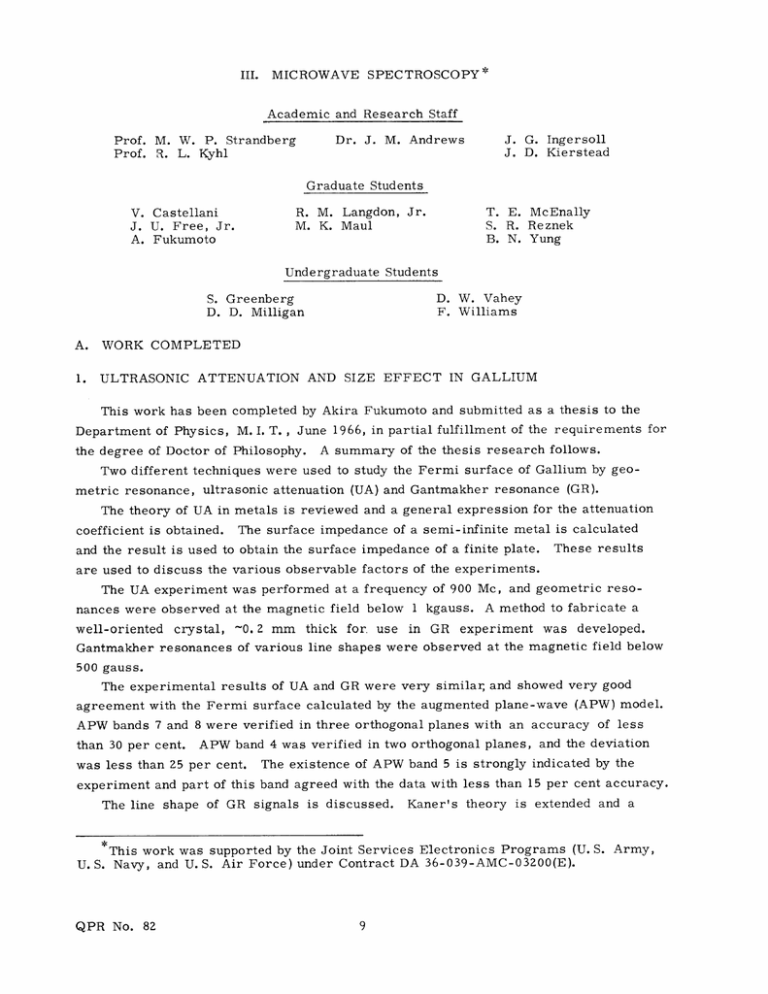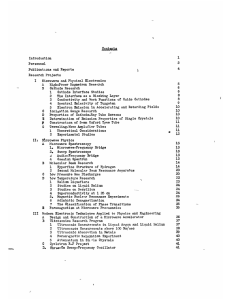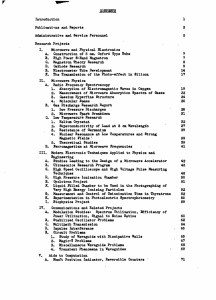III. MICROWAVE SPECTROSCOPY* Academic and Research Staff Strandberg
advertisement

III. MICROWAVE SPECTROSCOPY* Academic and Research Staff Dr. J. Prof. M. W. P. Strandberg Prof. R. L. Kyhl J. J. M. Andrews G. Ingersoll D. Kierstead Graduate Students T. E. McEnally S. R. Reznek B. N. Yung R. M. Langdon, Jr. M. K. Maul V. Castellani J. U. Free, Jr. A. Fukumoto Undergraduate Students D. W. Vahey F. Williams S. Greenberg D. D. Milligan A. WORK COMPLETED 1. ULTRASONIC ATTENUATION AND SIZE EFFECT IN GALLIUM This work has been completed by Akira Fukumoto and submitted as a thesis to the Department of Physics, M. I. T., June 1966, in partial fulfillment of the requirements for the degree of Doctor of Philosophy. A summary of the thesis research follows. Two different techniques were used to study the Fermi surface of Gallium by geometric resonance, ultrasonic attenuation (UA) and Gantmakher resonance (GR). The theory of UA in metals is reviewed and a general expression for the attenuation coefficient is obtained. The surface impedance of a semi-infinite metal is calculated and the result is used to obtain the surface impedance of a finite plate. These results are used to discuss the various observable factors of the experiments. The UA experiment was performed at a frequency of 900 Mc, nances were observed at the magnetic field below 1 kgauss. and geometric reso- A method to fabricate a crystal, "0. 2 mm thick for use in GR experiment was developed. Gantmakher resonances of various line shapes were observed at the magnetic field below well-oriented 500 gauss. The experimental results of UA and GR were very similar, and showed very good agreement with the Fermi surface calculated by the augmented plane-wave (APW) model. APW bands 7 and 8 were verified in three orthogonal planes with an accuracy of less than 30 per cent. APW band 4 was verified in two orthogonal planes, and the deviation was less than 25 per cent. The existence of APW band 5 is strongly indicated by the experiment and part of this band agreed with the data with less than 15 per cent accuracy. The line shape of GR signals is discussed. Kaner's theory is extended and a *This work was supported by the Joint Services Electronics Programs (U. S. Army, U. S. Navy, and U. S. Air Force) under Contract DA 36-039-AMC-03200(E). QPR No. 82 (III. MICROWAVE SPECTROSCOPY) discussion and calculation of the effect of interference the two opposing surfaces of a thin sample, as is the arrangement, is given. The interference effect of the two surfaces was studied by comparing the line shapes of the electric fields arising from case in the usual experimental electric fields arising from the of the samples with and without shielding on one side of the sample. The dependence of the line shape on the radio frequency and the polarization of the high-frequency field were studied, and a method was developed to obtain the correct value of the wave vector corresponding to the extremal orbits of the electrons. Temperature dependence of the attenuation coefficient of the UA experiment is discussed briefly. M. W. P. Strandberg 2. USE OF EMR TO STUDY MAGNETIC FIELD HOMOGENEITY AND CAVITY CONFIGURATIONS FOR LARGE AQUEOUS SAMPLES This work has been completed by David D. Milligan and submitted as a thesis to the Department of Physics, M. I. T. , June 1966, in partial fulfillment of the requirements for the degree of Bachelor of Science. A summary of the thesis research follows. The sensitivity of a helical resonator for use as a microwave cavity in an EMR spectrometer was investigated. By using experimental techniques and a theoretical analysis, the sensitivity of this type of helical resonator in studying aqueous samples was found to be inherently three orders of magnitude below the sensitivity obtained by using a standard cylindrical cavity with an unloaded Q of 25, 000. A simple and accurate technique for measuring static magnetic field homogeneity with the use of an EMR spectrometer is discussed and the use of "Rose Shims" to reduce inhomogeneity was studied. The magnetic field used in this laboratory is found to have an inhomogeneity of 0. 15 gauss per centimeter near the geometric center of the pole pieces. M. W. P. Strandberg 3. BOLOMETRIC DETECTION OF COHERENT PHONONS IN QUARTZ This work has been completed by David W. Vahey and submitted as a thesis to the Department of Physics, M. I. T. , June 1966, in partial fulfillment of the requirements for the degree of Bachelor of Science. A summary of the thesis research follows. Echoes of coherent phonons propagating through x-cut quartz were detected with a tin superconducting bolometer. The experiments were performed at liquid-helium temperatures with the use of a re-entrant microwave cavity capable of generating phonons near 9 Gc. Experimental results on bolometer responsivity are described and tentatively found to agree fairly well with the theory for bias currents up to 40 ma. QPR No. 82 (III. MICROWAVE SPECTROSCOPY) In other work, the decay constant for coherent 9-Gc phonon energy in the quartz-1 bolometer system has been measured bolometrically to be (0. 13 +. 035) cm- . This value is almost a factor of two less than that obtained under similar conditions with a microwave-reflection technique, and is believed to demonstrate the phase-sensitive properties of that method of measurement. Finally, the basis for experiments on phonon transmission across a quartz-indium interface is described in an appendix, and the results of a preliminary investigations are presented. M. W. P. Strandberg 4. APPARATUS FOR MEASURING PHONON DISPERSION IN SINGLE CRYSTALLINE MATERIAL This work has been completed by William B. Robbins and submitted as a thesis to the department of Physics, M. I. T. , January 1966, in partial fulfillment of the requirements for the degree of Bachelor of Science. A summary of the thesis research follows. Circuitry meeting the requirments for detection of phonon dispersion was developed in order to match a low impedance (2-ohm) superconducting bolometer to a higher impeddance (500-ohm) low-noise amplifier. The circuit operates at cryogenic temperatures, has a 10-90% rise time of 80 msec, produces less than 5% overshoot, and droops less than 20% for pulses of 10 psec duration. Theoretical calculations predict a droop ~18% and a rise time of ~100 nsec. The total circuit loss is less than 1. 6 db. No heat-pulse dispersion measurements were made, because of lack of time. M. W. P. Strandberg B. SUPERCONDUCTING BOLOMETERS: DETECTION OF AMBIENT ACOUSTIC NOISE We have observed the low-frequency (20 cps-20 kc) noise spectrum of a superconducting tin bolometer, and find that it has the following characteristics. 1. The noise spectral density varies as (frequency) - n, where n is 2 or slightly greater. 2. The magnitude of the noise spectral density depends upon whether or not the bolometer is immersed in the liquid-helium bath. 3. The magnitude of the noise sprectral density depends upon the phase of the liquid- helium bath, that is, whether it is Helium I or II. A plot of the noise spectral density is given in Fig. III-1. The characteristic frequency of the noise is so low (approaching zero frequency), and so much lower in magnitude in nonbubbling Helium II than in bubbling Helium I, that we are forced to conclude that the electrical ouput noise arises from the detection, by the bolometer, of the acoustic noise in bubbling liquid helium. The residual noise that is present when the bolometer is not physically immersed in liquid Helium II, may arise QPR No. 82 (III. MICROWAVE SPECTROSCOPY) AMPLIFIER NOISE -160 _ 50 Fig. III-i1. 100 200 400 800 1kc FREQUENCY Spectral noise density in a superconducting tin bolometer. from critical-point fluctuation in the bolometer superconducting normal phase transition. At the critical point this fluctuation spectrum would also have a characteristic frequency that approaches zero. This critical-point fluctuation noise should be independent of whether or not the bolometer is in physical contact with the liquid Helium bath; it is more probable that the residual noise is simply laboratory ambient acoustic noise detected by the bolometer. The increase in the magnitude of the noise with immersion of the bolometer in the liquid-helium bath would seem to eliminate the transit of quantized flux vertices1 as a source of this noise. M. W. P. Strandberg, J. D. Kierstead References 1. D. J. C. van Ooijen and G. J. BOLOMETRIC van Gurp, Phys. Letters 17 230 (15 July 1966). DETECTION OF COHERENT 9-GHz LONGITUDINAL PHONONS IN x-CUT QUARTZ A superconducting bolometer I has been utilized for the detection of coherent 9.0-GHz longitudinal phonons in an x-cut quartz rod. QPR No. 82 A bolometer is an energy-sensing device, (III. MICROWAVE SPECTROSCOPY) and the complications associated with the phase-averaging process within the re-entrant cavity of a conventional microwave ultrasonic receiver, often giving rise to ragged, 2-6 and are thereby circumvented. It has been nonexponential echo-decay envelopes, pointed out,6 furthermore, that even when nearly exponential decay envelopes are observed in convential microwave ultrasonic experiments, the apparent loss of ultrasonic energy associated with the geometric effect of nonparallelism of the sample end faces combined with crystalline axis misalignment may greatly exceed the actual intrinsic loss caused by crystalline imperfections. In studies of the temperature dependence of phonon-phonon scattering, an exponential decay envelope is not needed. The height of an echo that has made many passes through the sample is measured relative to its value at 4. 2 0 K, where the phonon-phonon scattering is negligible in comparison with the temperature-independent residual attenuation. Thus, although phonon-phonon scattering at microwave frequencies has been investigated in considerable detail in a wide variety of materials and at frequencies as high as 70 GHz in quartz, 7 the absolute value of the residual attenuation at temperatures below 4. 2. 'K has remained a moot issue, because of the evolution of an unknown phase distribution of the microwave field over the receiving surface of the sample in multiplereflection experiments. For our experiment a quartz rod was selected that was known to have a rather high residual attenuation below 4. 2 0 K. Thus the attenuation was sufficiently high to greatly diminish the usual "beating" effects often observed in microwave ultrasonic attenuation experiments, 2 6 and a very nearly exponential decay of the pulse-echo envelope was observed with the microwave receiver, by utilizing a calibration pulse for pulseheight comparison measurements. As shown in Fig. III-1, microwave ultrasonic gen- eration and reception is performed in the same X-band re-entrant cavity at one end of the quartz rod. The measurements of pulse-echo power, detected in the microwave cavity, are shown by the upper line in Fig. 111-3. Clearly, beating effects are not very evident in these measurements. The quartz rod utilized in this experiment was 19 mm long, and therefore the ultrasonic attenuation coefficient derived from these microwave measurements at 9. O0GHz was 1 db/cm. At the other end of the quartz rod shown in Fig. 111-2, a tin film, approximately 0. 1 j thick, was deposited. The experiments were carried out at the superconducting transition temperature of the tin (3. 7"K) so that the ultrasonic pulses could also be detected bolometrically. These measurements are shown by the lower line in Fig. III- 3. The ultrasonic attenuation coefficient derived from the bolometric measurements at 9. O0GHz was 0. 6 db/cm. Comparison of the data taken from the two types of attenuation measurements, as shown in Fig. 111-3, indicates that the microwave re-entrant cavity technique introduces an additional factor of 0. 4 db/cm in the apparent attenuation measurement. QPR No. 82 This X-BAND WAVEGUIDE SUPERCONDUCTING BOLOMETER MICROWAVE PULSE X-CUT QUARTZ ROD ECHO PULSES TO VIDEO AMPLIFIER Fig. III-2. Generation and detection of microwave phonons at 9. O0GHz. Microwave ultrasonic pulses propagating in the x-cut quartz rod are detected by the conventional, re-entrant cavity method at the left end, and by a superconducting bolometer at the right end. 30 MICROWAVE DATA 24 O I u 18 0 BOLOMETER DATA 12 - 2 3 4 5 6 7 8 ECHO NUMBER Fig. III-3. QPR No. 82 Measurements of the ultrasonic attenuation of longitudinal 9. 0-GHz phonons in an x-cut quartz rod, 19 mm long. The upper line represents measurements of microwave pulses received by the re-entrant cavity. The lower line represents measurements of the same pulses received by a superconducting bolometer at the opposite end of the quartz rod. The higher attenuation observed in the re-entrant cavity is attributed to unknown phase averaging of the microwave field over the end face of the quartz rod. (III. MICROWAVE SPECTROSCOPY) discrepancy is ostensibly related to the averaging of the unknown phase distribution of the microwave field over the receiving surface of the x-cut quartz sample. The use of a metallic film for the detection of ultrasonic energy raises the disquieting question of how much of the energy is absorbed by the film in the detection process. At low temperatures the conduction electrons contribute heavily to the ultrasonic attenuation process in metals whenever their mean-free path becomes comparable to the ultrasonic wave length. In our bolometric film the electronic mean-free path is limited by boundary scattering to approximately one-third of the ultrasonic wavelength. The theory of the electronic contribution to the ultrasonic attenuation in metals derived by Pippard8 yields an absorption of approximately 0. 03 db per echo in the superconducting film. This small value is consistent with the fact that we could see no change in the microwave attenuation as the tin film was driven from the superconducting to the normal state by means of an external magnetic field. The highest frequency at which Pippard's theory has been verified is 0. 9 GHz. 9 It is therefore desirable to have an additional experimental check at 9 GHz. This has been carried out by evaporating a relatively thick (1 i) indium film on another quartz rod in place of the bolometer and performing microwave attenuation measurements in this rod with the apparatus shown in Fig. 11-2. The ultrasonic impedance of the longitudinal mode in indium is very nearly equal to 3.0- 2.0- 2 ECHO NUMBER Fig. 111-4. QPR No. 82 Electronic contribution to ultrasonic attenuation at 9. 0 GHz in an indium film, approximately 1 V thick. The difference in pulse-echo height, as the film is driven from the superconducting to the normal state, is represented by A. (III. that in x-cut quartz. MICROWAVE SPECTROSCOPY) It is therefore reasonable to assume that virtually all of the ultra- sonic energy incident upon the quartz-metal interface is transmitted into the film. This contention is supported by the comparison of our experimental results with theory. The indium film was driven from the superconducting to the normal state by the application of an external magnetic field, and the relative changes in the heights of three echoes were measured. These data are shown in Fig. 111-4. An absorption of 0.07 db per echo is consistent with Pippard's theory if the effective number of free electrons per atom is taken as two. This is the same value as that required in a comparison of the Pippard theory with ultrasonic attenuation measurements in indium at 0. 165 and 0. 91 GHz. 9 The ultrasonic attenuation measurement in the thick film supports our previous estimate of the relatively small absorption coefficient of our bolometric detector. Furthermore, these detectors can be made considerably thinner than 0.1 p. It therefore appears that the superconducting bolometer may be useful as a phase-insensitive detector that can be utilized for absolute ultrasonic attenuation measurements at microwave frequencies where unknown phase averaging of the microwave field complicates the interpretation of data obtained by conventional re-entrant cavity reception. The author would like to acknowledge the assistance of David W. Vahey who performed some of the experiments. J. M. Andrews, Jr. References 1. J. M. Andrews, Jr., and M. W. P. Strandberg, Proc. IEEE 54, 523-528 (1966). 2. R. Nava, R. Azrt, I. Ciccarello, and K. Dransfeld, Phys. Rev. 134, A581-589 (1964). 3. 4. I. S. Ciccarello and K. Dransfeld, Phys. Rev. 134, A1517-1520 (1964). E. Gates, Appl. Phys. Letters 7, 187-189 (1965). 5. E. G. Spencer, P. V. Lenzo, and K. Nassau, Appl. Phys. Letters 7, 67 (1965). 6. E. Gates, Proc. IEEE 52, 1129-1137 (1964). 7. J. B. Thaxter and P. E. Tannenwald, (to be published). 8. A. B. Pippard, Repts. Progr. Phys. 23, 9. J. M. Andrews, Jr., Ph. D. Thesis, Massachusetts Institute of Technology, Cambridge, Mass. , February 1964 (unpublished). D. ERRATUM: Proc. IEEE Trans. on Sonics and Ultrasonics 176 (1960). MINIMUM DETECTABLE POWER IN SUPERCONDUCTING BOLOMETERS In Quarterly Progress Report No. 81, page 1, the last line should be changed to read: "the rms equivalent input noise power arising from the three processes is given by". J. M. Andrews, QPR No. 82 Jr.



